Melt-Spun Photoluminescent Polymer Optical Fibers for Color-Tunable Textile Illumination
Abstract
:1. Introduction
2. Materials and Methods
2.1. Materials
2.2. Preparation of Photoluminescent POFs
2.3. Preparation of Photoluminescent Yarns
2.4. Preparation of Photoluminescent Textiles
2.5. Fiber-to-Fiber Light Transfer Measurements
2.6. Measurements of Absorption and Emission Spectra of the Dyes in Acetone
3. Results
3.1. Optical Performance of Photoluminescent Yarns
3.2. Optical Performance of Photoluminescent Textiles
4. Discussion and Conclusions
Author Contributions
Funding
Institutional Review Board Statement
Informed Consent Statement
Data Availability Statement
Acknowledgments
Conflicts of Interest
References
- Shanks, K.; Senthilarasu, S.; Mallick, T.K. Optics for concentrating photovoltaics: Trends, limits and opportunities for materials and design. Renew. Sustain. Energy Rev. 2016, 60, 394–407. [Google Scholar] [CrossRef] [Green Version]
- Van Dijk, L.; Marcus, E.A.P.; Oostra, A.J.; Schropp, R.E.I.; Di Vece, M. 3D-printed concentrator arrays for external light trapping on thin film solar cells. Sol. Energy Mater. Sol. Cells 2015, 139, 19–26. [Google Scholar] [CrossRef] [Green Version]
- Smestad, G.; Ries, H.; Winston, R.; Yablonovitch, E. The thermodynamic limits of light concentrators. Sol. Energy Mater. 1990, 21, 99–111. [Google Scholar] [CrossRef]
- Shen, Y.; Jia, Y.; Sheng, X.; Shen, L.; Rogers, J.A.; Giebink, N.C. Nonimaging Optical Gain in Luminescent Concentration through Photonic Control of Emission Étendue. ACS Photonics 2014, 1, 746–753. [Google Scholar] [CrossRef]
- Manousiadis, P.P.; Rajbhandari, S.; Mulyawan, R.; Vithanage, D.A.; Chun, H.; Faulkner, G.; O’Brien, D.C.; Turnbull, G.A.; Collins, S.; Samuel, I.D.W. Wide field-of-view fluorescent antenna for visible light communications beyond the étendue limit. Optica 2016, 3, 702. [Google Scholar] [CrossRef]
- Weber, W.H.; Lambe, J. Luminescent greenhouse collector for solar radiation. Appl. Opt. 1976, 15, 2299. [Google Scholar] [CrossRef]
- Reisfeld, R. New developments in luminescence for solar energy utilization. Opt. Mater. 2010, 32, 850–856. [Google Scholar] [CrossRef]
- Rafiee, M.; Chandra, S.; Ahmed, H.; McCormack, S.J. An overview of various configurations of Luminescent Solar Concentrators for photovoltaic applications. Opt. Mater. 2019, 91, 212–227. [Google Scholar] [CrossRef]
- Zhao, Y.; Lunt, R.R. Transparent luminescent solar concentrators for large-area solar windows enabled by massive stokes-shift nanocluster phosphors. Adv. Energy Mater. 2013, 3, 1143–1148. [Google Scholar] [CrossRef]
- Roncali, J. Luminescent Solar Collectors: Quo Vadis? Adv. Energy Mater. 2020, 10, 2001907. [Google Scholar] [CrossRef]
- Fischer, S.; Diesner, T.; Rieger, B.; Marti, O. Simulating and evaluating small-angle X-ray scattering of micro-voids in polypropylene during mechanical deformation. J. Appl. Crystallogr. 2010, 43, 603–610. [Google Scholar] [CrossRef]
- Papakonstantinou, I.; Portnoi, M.; Debije, M.G. The Hidden Potential of Luminescent Solar Concentrators. Adv. Energy Mater. 2021, 11, 2002883. [Google Scholar] [CrossRef]
- Portnoi, M.; Haigh, P.A.; Macdonald, T.J.; Ambroz, F.; Parkin, I.P.; Darwazeh, I.; Papakonstantinou, I. Bandwidth limits of luminescent solar concentrators as detectors in free-space optical communication systems. Light Sci. Appl. 2021, 10, 3. [Google Scholar] [CrossRef]
- Jakubowski, K.; Kerkemeyer, W.; Perret, E.; Heuberger, M.; Hufenus, R. Liquid-core polymer optical fibers for luminescent waveguide applications. Mater. Des. 2020, 109131. [Google Scholar] [CrossRef]
- He, Y.; Du, E.; Zhou, X.; Zhou, J.; He, Y.; Ye, Y.; Wang, J.; Tang, B.; Wang, X. Wet-spinning of fluorescent fibers based on gold nanoclusters-loaded alginate for sensing of heavy metal ions and anti-counterfeiting. Spectrochim. Acta Part A Mol. Biomol. Spectrosc. 2020, 230, 118031. [Google Scholar] [CrossRef]
- He, J.; Chan, W.-K.; Cheng, X.; Tse, M.-L.; Lu, C.; Wai, P.-K.; Savovic, S.; Tam, H.-Y. Experimental and Theoretical Investigation of the Polymer Optical Fiber Random Laser with Resonant Feedback. Adv. Opt. Mater. 2018, 6, 1701187. [Google Scholar] [CrossRef]
- Hufenus, R.; Yan, Y.; Dauner, M.; Kikutani, T. Melt-Spun Fibers for Textile Applications. Materials 2020, 13, 4298. [Google Scholar] [CrossRef] [PubMed]
- Jakubowski, K.; Huang, C.-S.; Boesel, L.F.; Hufenus, R.; Heuberger, M. Recent advances in photoluminescent polymer optical fibers. Curr. Opin. Solid State Mater. Sci. 2021, 25, 100912. [Google Scholar] [CrossRef]
- Jakubowski, K.; Huang, C.-S.; Gooneie, A.; Boesel, L.F.; Heuberger, M.; Hufenus, R. Luminescent solar concentrators based on melt-spun polymer optical fibers. Mater. Des. 2020, 108518. [Google Scholar] [CrossRef]
- Riaz, A.; Faulkner, G.; Collins, S. A Fluorescent Antenna for White Light Visible Light Communications. In Proceedings of the 2019 Global LIFI Congress (GLC), Paris, France, 12–13 June 2019; pp. 1–4. [Google Scholar]
- Peyronel, T.; Quirk, K.J.; Wang, S.C.; Tiecke, T.G. Luminescent detector for free-space optical communication. Optica 2016, 3, 787. [Google Scholar] [CrossRef]
- Stepniak, G.; Schüppert, M.; Bunge, C.A. Polymer-Optical Fibres for Data Transmission; Elsevier: Amsterdam, The Netherlands, 2016; ISBN 9780081000564. [Google Scholar]
- Quandt, B.M.; Braun, F.; Ferrario, D.; Rossi, R.M.; Scheel-Sailer, A.; Wolf, M.; Bona, G.-L.; Hufenus, R.; Scherer, L.J.; Boesel, L.F. Body-monitoring with photonic textiles: A reflective heartbeat sensor based on polymer optical fibres. J. R. Soc. Interface 2017, 14. [Google Scholar] [CrossRef] [Green Version]
- Quandt, B.M.; Hufenus, R.; Weisse, B.; Braun, F.; Wolf, M.; Scheel-Sailer, A.; Bona, G.-L.; Rossi, R.M.; Boesel, L.F. Optimization of novel melt-extruded polymer optical fibers designed for pressure sensor applications. Eur. Polym. J. 2017, 88, 44–55. [Google Scholar] [CrossRef]
- Videira, J.; Bilotti, E.; Chatten, A. Cylindrical array luminescent solar concentrators: Performance boosts by geometric effects. Opt. Express 2016, 24, 285–290. [Google Scholar] [CrossRef] [PubMed] [Green Version]
- Balaban, B.; Doshay, S.; Osborn, M.; Rodriguez, Y.; Carter, S.A. The role of FRET in solar concentrator efficiency and color tunability. J. Lumin. 2014, 146, 256–262. [Google Scholar] [CrossRef]
- Huang, C.-S.; Jakubowski, K.; Ulrich, S.; Yakunin, S.; Clerc, M.; Toncelli, C.; Rossi, R.M.; Kovalenko, M.V.; Boesel, L.F. Nano-domains assisted energy transfer in amphiphilic polymer conetworks for wearable luminescent solar concentrators. Nano Energy 2020, 76. [Google Scholar] [CrossRef]
- Hsu, C.-P.; Hejazi, Z.; Armagan, E.; Zhao, S.; Schmid, M.; Zhang, H.; Guo, H.; Weidenbacher, L.; Rossi, R.M.; Koebel, M.M.; et al. Carbon dots and fluorescein: The ideal FRET pair for the fabrication of a precise and fully reversible ammonia sensor. Sens. Actuators B Chem. 2017, 253, 714–722. [Google Scholar] [CrossRef]
- Weiss, J.D. Trapping efficiency of fluorescent optical fibers. Opt. Eng. 2015, 54, 027101. [Google Scholar] [CrossRef] [Green Version]
- Parola, I.; Zaremba, D.; Evert, R.; Kielhorn, J.; Jakobs, F.; Illarramendi, M.A.; Zubia, J.; Kowalsky, W.; Johannes, H.H. High performance fluorescent fiber solar concentrators employing double-doped polymer optical fibers. Sol. Energy Mater. Sol. Cells 2018, 178, 20–28. [Google Scholar] [CrossRef]
- Parola, I.; Illarramendi, M.A.; Jakobs, F.; Kielhorn, J.; Zaremba, D.; Johannes, H.-H.; Zubia, J. Characterization of Double-Doped Polymer Optical Fibers as Luminescent Solar Concentrators. Polymers 2019, 11, 1187. [Google Scholar] [CrossRef] [Green Version]
- Krumer, Z.; van Sark, W.G.J.H.M.; Schropp, R.E.I.; de Mello Donegá, C. Compensation of self-absorption losses in luminescent solar concentrators by increasing luminophore concentration. Sol. Energy Mater. Sol. Cells 2017, 167, 133–139. [Google Scholar] [CrossRef]
- Ding, W.; Sun, J.; Chen, G.; Zhou, L.; Wang, J.; Gu, X.; Wan, J.; Pu, X.; Tang, B.; Wang, Z.L. Stretchable multi-luminescent fibers with AIEgens. J. Mater. Chem. C 2019, 7, 10769–10776. [Google Scholar] [CrossRef]
- Lin, C.C.; Jiang, D.-H.; Kuo, C.-C.; Cho, C.-J.; Tsai, Y.-H.; Satoh, T.; Su, C. Water-Resistant Efficient Stretchable Perovskite-Embedded Fiber Membranes for Light-Emitting Diodes. ACS Appl. Mater. Interfaces 2018, 10, 2210–2215. [Google Scholar] [CrossRef] [PubMed]
- Miluski, P.; Dorosz, D.; Kochanowicz, M.; Żmojda, J. Fluorescent polymeric optical fibre illuminator. Electron. Lett. 2016, 52, 1550–1552. [Google Scholar] [CrossRef]
- Cennamo, N.; Mattiello, F.; Galatus, R.V.; Voiculescu, E.; Zeni, L. Plasmonic Sensing in D-Shaped POFs With Fluorescent Optical Fibers as Light Sources. IEEE Trans. Instrum. Meas. 2018, 67, 754–759. [Google Scholar] [CrossRef]
- Hufenus, R.; Yan, Y.; Dauner, M.; Yao, D.; Kikutani, T. Bicomponent Fibers. In Handbook of Fibrous Materials; Wiley: Hoboken, NJ, USA, 2020; pp. 281–313. [Google Scholar]
- Reifler, F.A.; Hufenus, R.; Krehel, M.; Zgraggen, E.; Rossi, R.M.; Scherer, L.J. Polymer optical fibers for textile applications—Bicomponent melt spinning from cyclic olefin polymer and structural characteristics revealed by wide angle X-ray diffraction. Polymer 2014, 55, 5695–5707. [Google Scholar] [CrossRef]
- Sádecká, J.; Tóthová, J. Fluorescence spectroscopy and chemometrics in the food classification—A review. Czech J. Food Sci. 2008, 25, 159–174. [Google Scholar] [CrossRef] [Green Version]
- Bunge, C.A.; Beckers, M.; Lustermann, B. Basic Principles of Optical Fibres; Elsevier Ltd.: Amsterdam, The Netherlands, 2016; ISBN 9780081000564. [Google Scholar]
- Wu, W.; Wang, T.; Wang, X.; Wu, S.; Luo, Y.; Tian, X.; Zhang, Q. Hybrid solar concentrator with zero self-absorption loss. Sol. Energy 2010, 84, 2140–2145. [Google Scholar] [CrossRef]
- Gaigalas, A.K.; Wang, L.L.; Schwartz, A.; Marti, G.E.; Vogt, R.F. Quantitating fluorescence intensity from fluorophore: Assignment of MESF values. J. Res. Natl. Inst. Stand. Technol. 2005, 110, 101. [Google Scholar] [CrossRef]
- Griffini, G. Host Matrix Materials for Luminescent Solar Concentrators: Recent Achievements and Forthcoming Challenges. Front. Mater. 2019, 6. [Google Scholar] [CrossRef] [Green Version]
- Huang, Y.; Xing, J.; Gong, Q.; Chen, L.-C.; Liu, G.; Yao, C.; Wang, Z.; Zhang, H.-L.; Chen, Z.; Zhang, Q. Reducing aggregation caused quenching effect through co-assembly of PAH chromophores and molecular barriers. Nat. Commun. 2019, 10, 169. [Google Scholar] [CrossRef] [Green Version]
- Yang, D.; Liang, H.; Liu, Y.; Hou, M.; Kan, L.; Yang, Y.; Zang, Z. A large-area luminescent downshifting layer containing an Eu 3+ complex for crystalline silicon solar cells. Dalt. Trans. 2020, 49, 4725–4731. [Google Scholar] [CrossRef] [PubMed]
- Lakowicz, J.R. Principles of Fluorescence Spectroscopy, 2nd ed.; Lakowicz, J.R., Ed.; Springer: Boston, MA, USA, 2006; ISBN 978-0-387-31278-1. [Google Scholar]
- Dixit, M.; Mathur, V.; Gupta, S.; Baboo, M.; Sharma, K.; Saxena, N.S. Morphology, miscibility and mechanical properties of PMMA/PC blends. Phase Transit. 2009, 82, 866–878. [Google Scholar] [CrossRef]
- Kooroshnia, M. Designing a two-phase glow-in-the-dark pattern on textiles. In Proceedings of the Shapeshifting: A Conference on Transformative Paradigms of Fashion and Textile Design, Auckland, New Zealand, 14–16 April 2014. [Google Scholar]
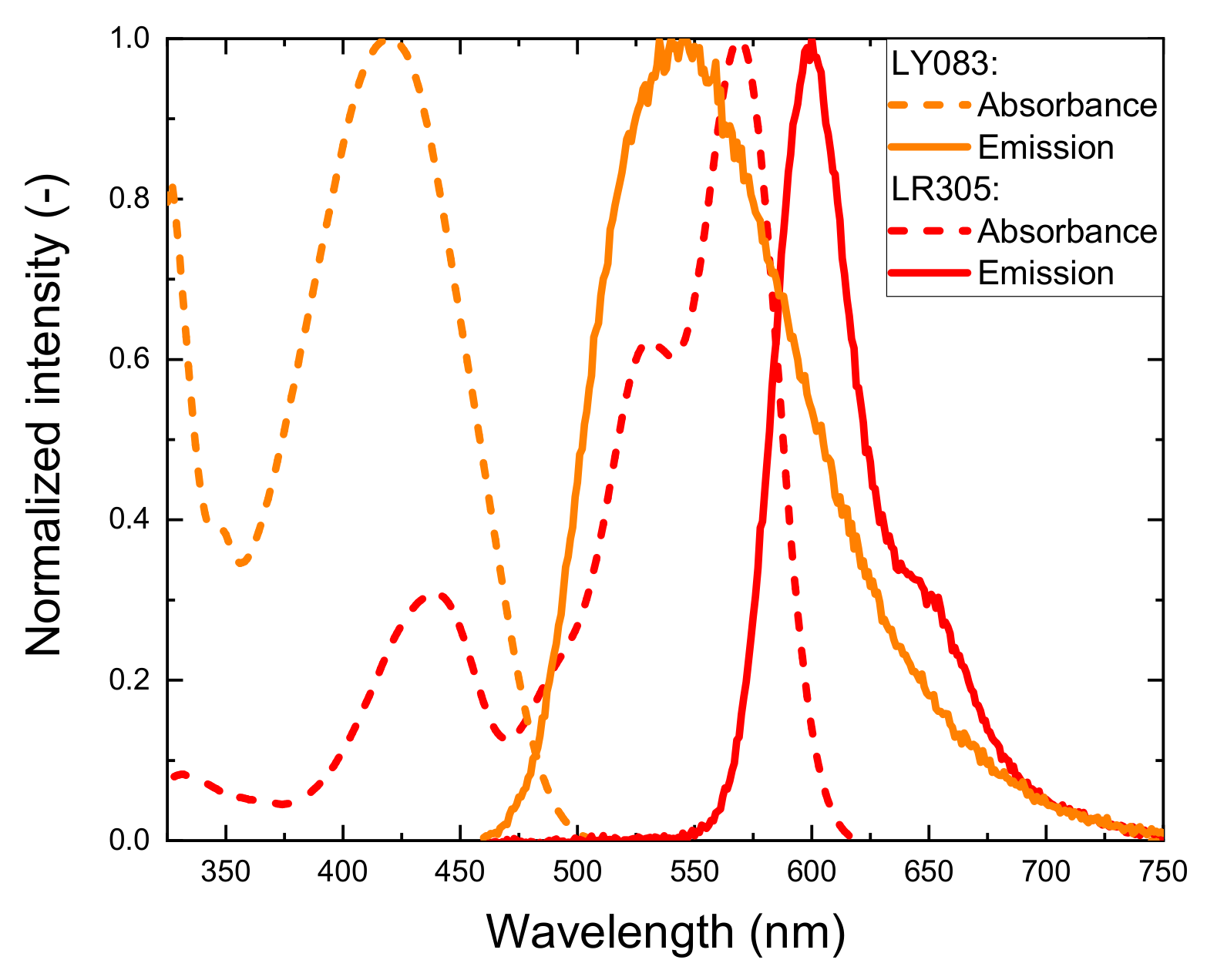
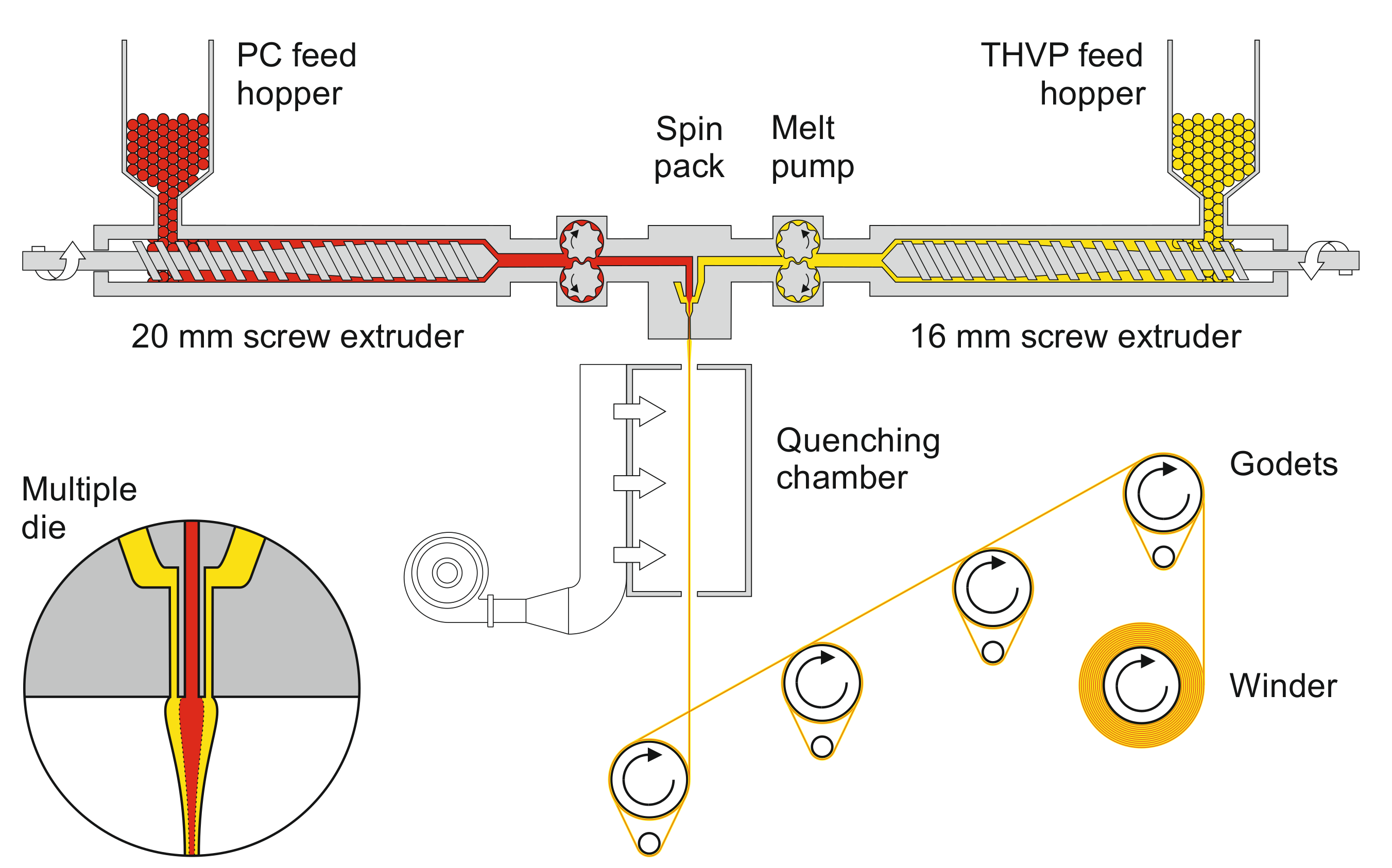
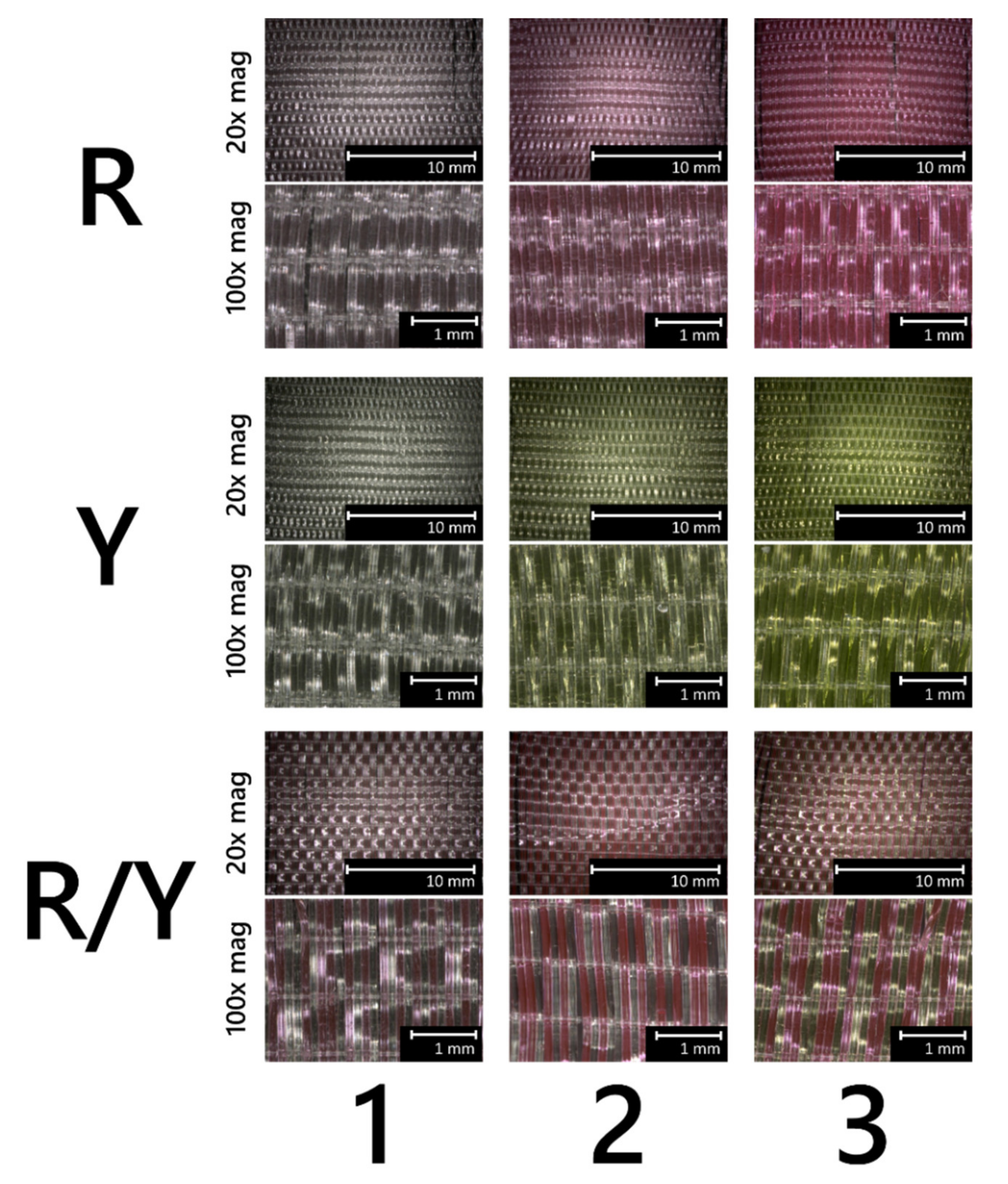


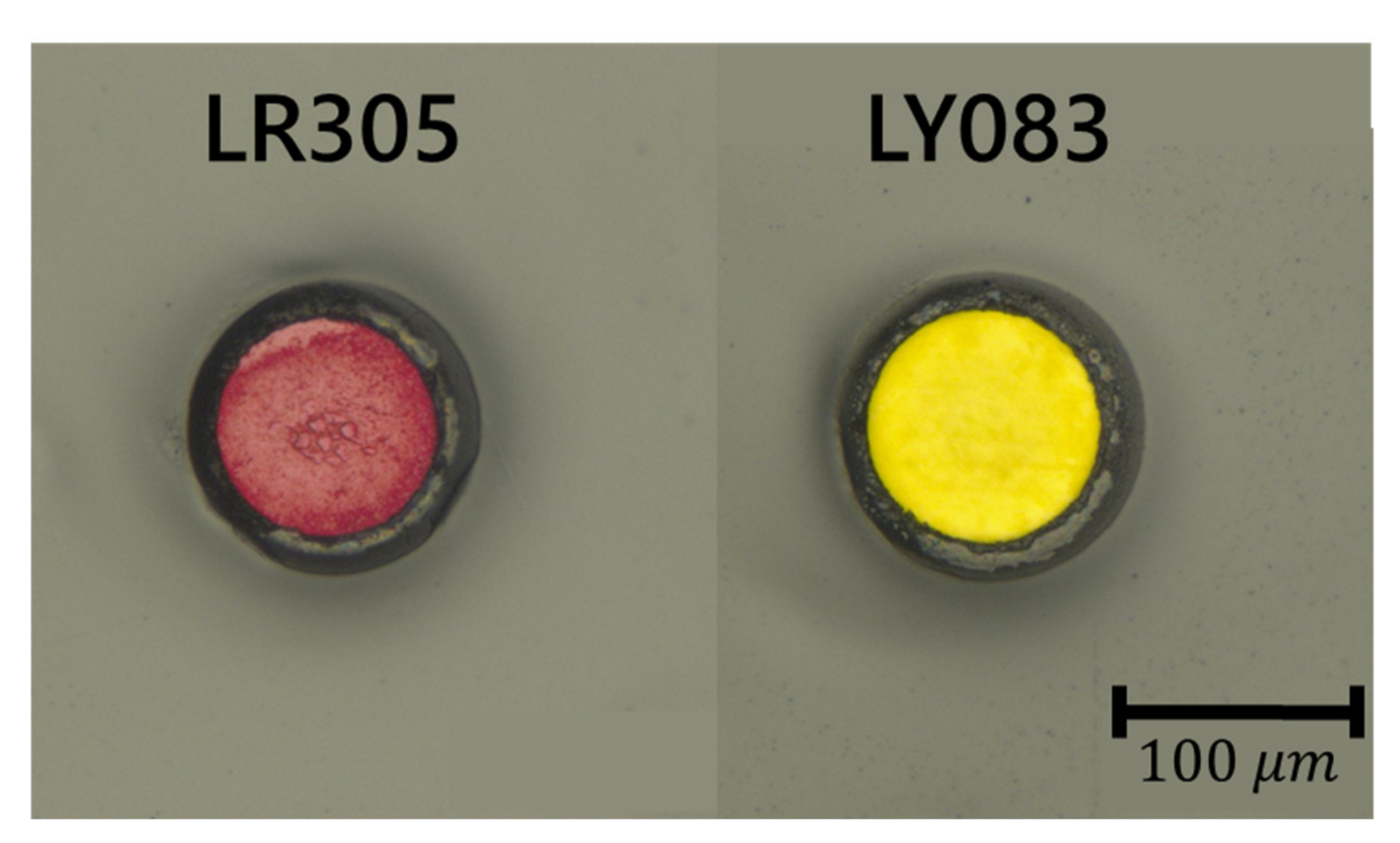
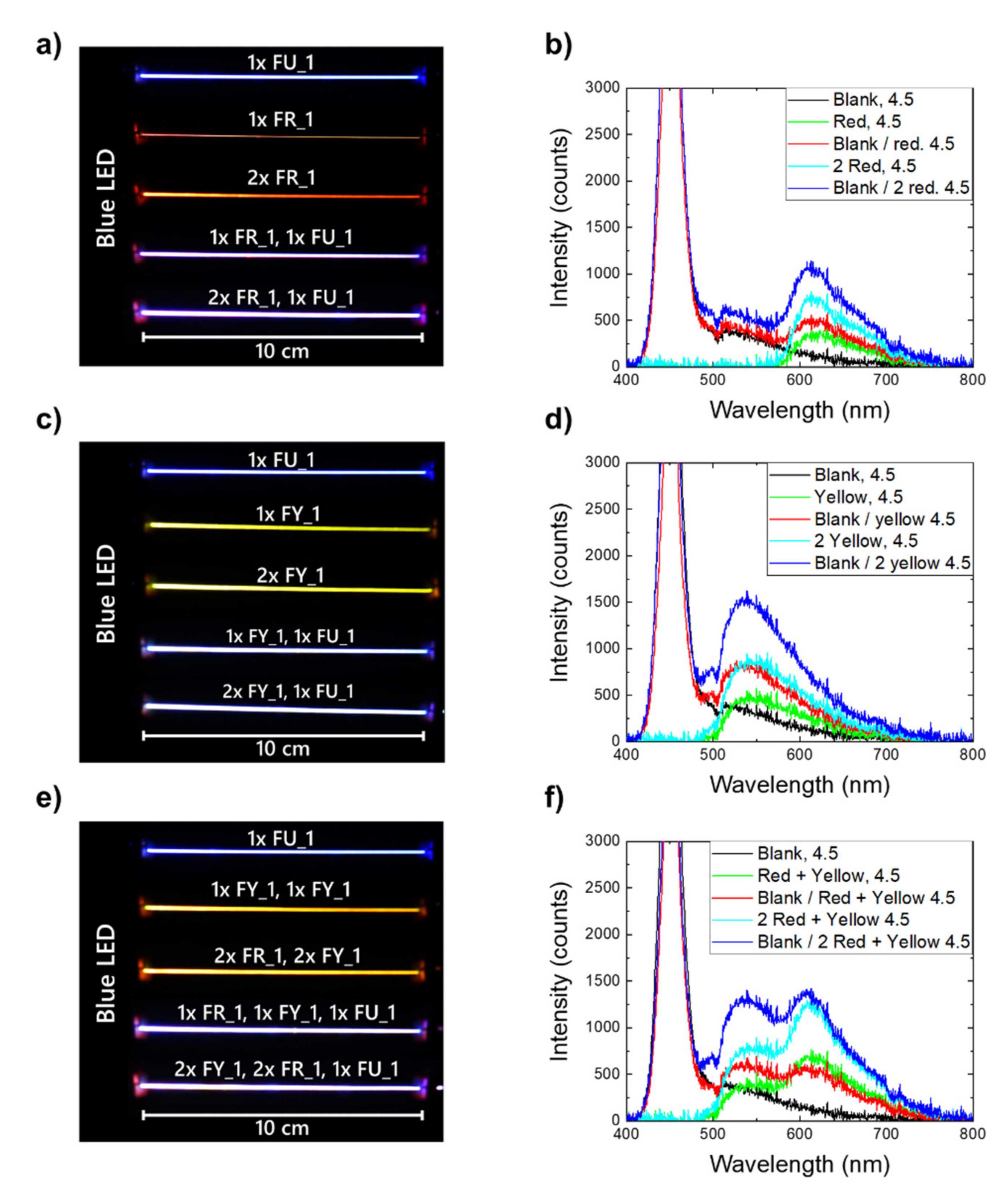

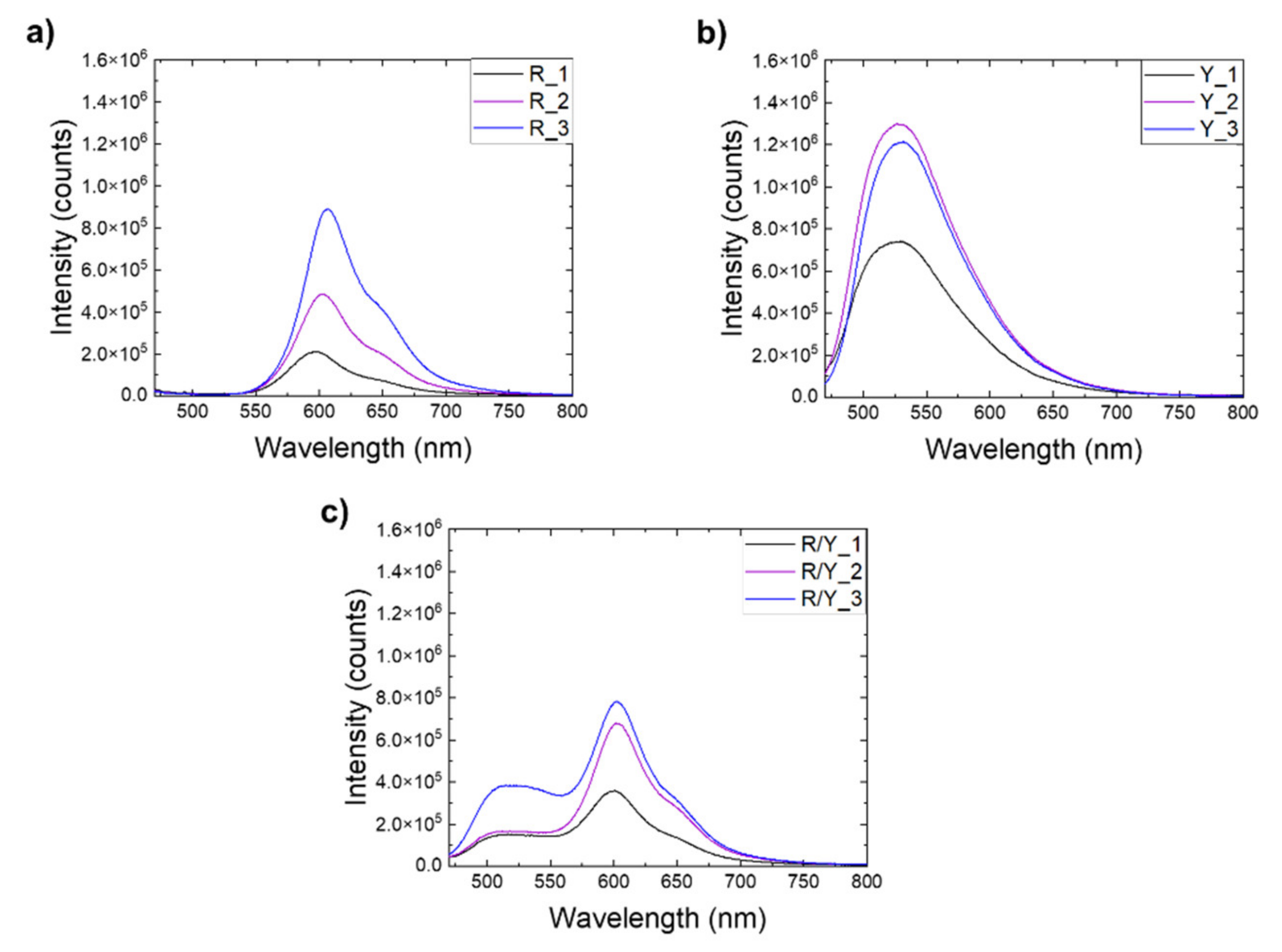
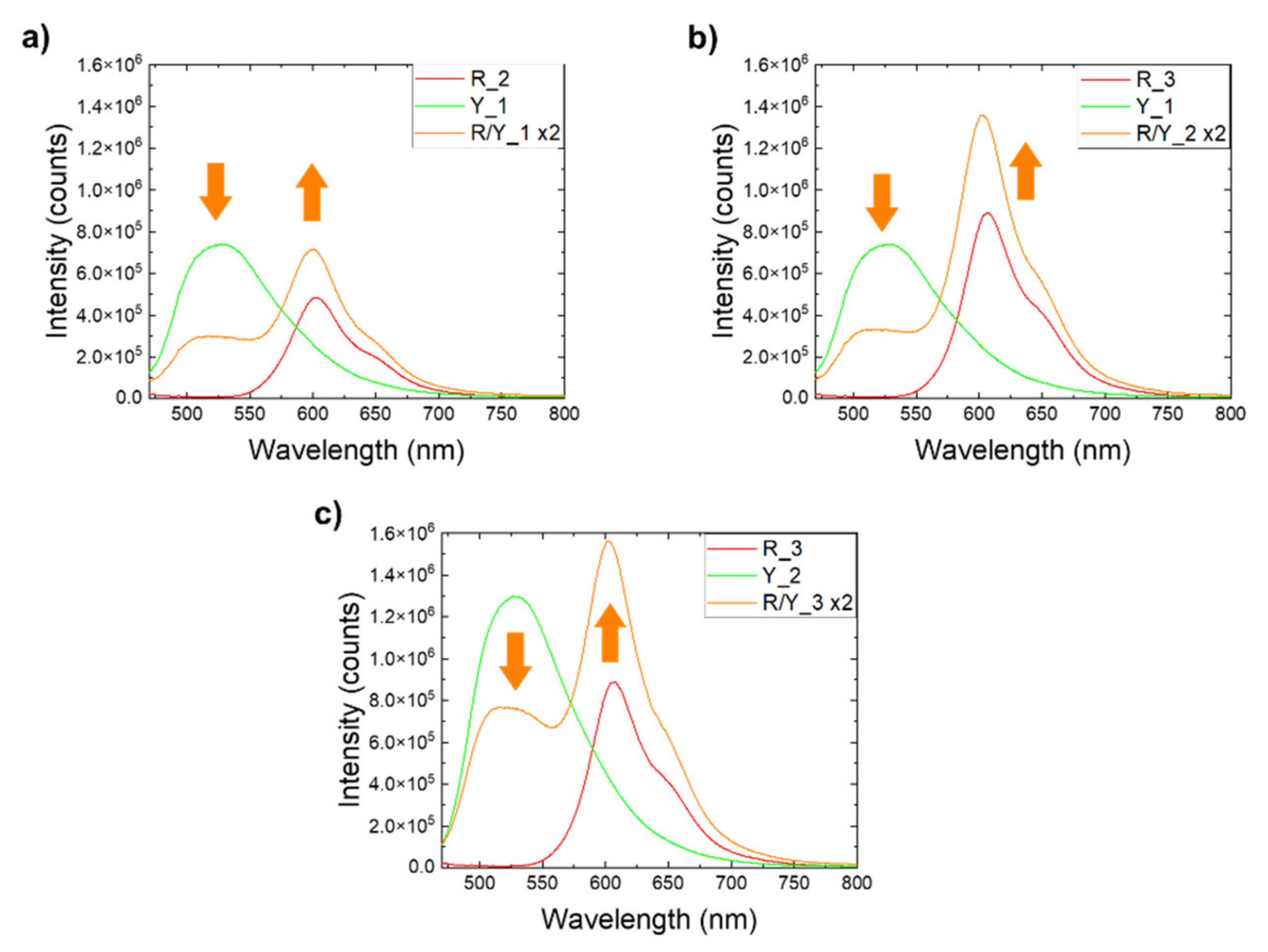
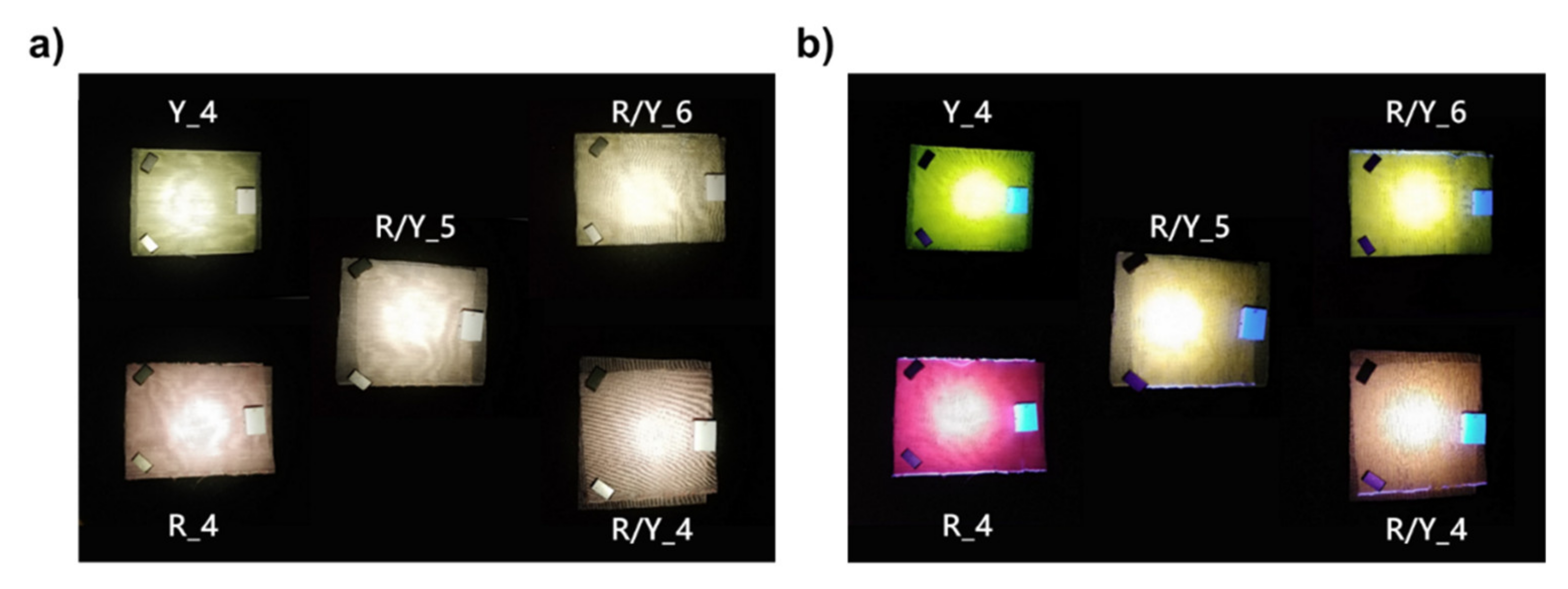
| Fiber Designation | Dye Concentration (wt.%) | Throughput Core/Sheath (cm3/min) | Melt Temperature Core/Sheath (°C) | Spin Pressure Core/Sheath (bar) | Draw Ratio | Winding Speed (m/min) |
|---|---|---|---|---|---|---|
| FU_1 | None | 7.5/9.0 | 298/280 | 94/68 | 2.0 | 900 |
| FR_1 | LR305 (0.01) | 7.5/9.0 | 297/280 | 128/69 | 2.0 | 900 |
| FY_1 | LY083 (0.01) | 7.5/9.0 | 298/280 | 110/69 | 2.2 | 1060 |
| FR_2 | LR305 (0.05) | 3.0/3.0 | 291/269 | 93/117 | 2.1 | 410 |
| FY_2 | LY083 (0.05) | 3.0/3.0 | 291/275 | 81/98 | 2.1 | 410 |
| FR_3 | LR305 (0.1) | 3.0/3.0 | 291/269 | 81/98 | 2.1 | 410 |
| FY_3 | LY083 (0.1) | 3.0/3.0 | 291/275 | 74/93 | 2.1 | 410 |
| Fabric Designation | FR_1 | FR_2 | FR_3 | FY_1 | FY_2 | FY_3 |
|---|---|---|---|---|---|---|
| R_1 | 2 | |||||
| R_2 | 2 | |||||
| R_3 | 2 | |||||
| R_4 | 8 | |||||
| Y_1 | 2 | |||||
| Y_2 | 2 | |||||
| Y_3 | 2 | |||||
| Y_4 | 8 | |||||
| R/Y_1 | 2 | 2 | ||||
| R/Y_2 | 2 | 2 | ||||
| R/Y_3 | 2 | 2 | ||||
| R/Y_4 | 6 | 2 | ||||
| R/Y_5 | 4 | 4 | ||||
| R/Y_6 | 2 | 6 |
| R_2 | R_3 | Y_1 | Y_2 | R/Y_1 | R/Y_2 | R/Y_3 | |
|---|---|---|---|---|---|---|---|
| Integrated emission (counts × nm) | 3.55 × 107 | 6.30 × 107 | 7.85 × 107 | 1.32 × 107 | 7.64 × 107 | 1.23 × 108 | 1.71 × 108 |
| (-) | - | - | - | - | 0.33 | 0.13 | 0.12 |
Publisher’s Note: MDPI stays neutral with regard to jurisdictional claims in published maps and institutional affiliations. |
© 2021 by the authors. Licensee MDPI, Basel, Switzerland. This article is an open access article distributed under the terms and conditions of the Creative Commons Attribution (CC BY) license (https://creativecommons.org/licenses/by/4.0/).
Share and Cite
Jakubowski, K.; Heuberger, M.; Hufenus, R. Melt-Spun Photoluminescent Polymer Optical Fibers for Color-Tunable Textile Illumination. Materials 2021, 14, 1740. https://doi.org/10.3390/ma14071740
Jakubowski K, Heuberger M, Hufenus R. Melt-Spun Photoluminescent Polymer Optical Fibers for Color-Tunable Textile Illumination. Materials. 2021; 14(7):1740. https://doi.org/10.3390/ma14071740
Chicago/Turabian StyleJakubowski, Konrad, Manfred Heuberger, and Rudolf Hufenus. 2021. "Melt-Spun Photoluminescent Polymer Optical Fibers for Color-Tunable Textile Illumination" Materials 14, no. 7: 1740. https://doi.org/10.3390/ma14071740
APA StyleJakubowski, K., Heuberger, M., & Hufenus, R. (2021). Melt-Spun Photoluminescent Polymer Optical Fibers for Color-Tunable Textile Illumination. Materials, 14(7), 1740. https://doi.org/10.3390/ma14071740






